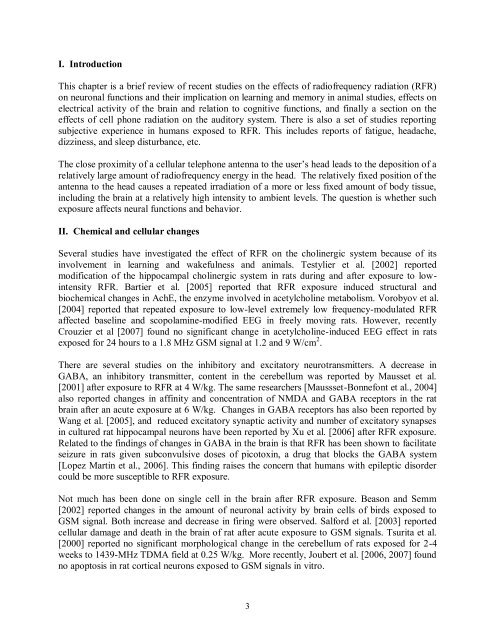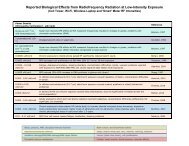Evidence for Effects on Neurology and Behavior - BioInitiative Report
Evidence for Effects on Neurology and Behavior - BioInitiative Report
Evidence for Effects on Neurology and Behavior - BioInitiative Report
You also want an ePaper? Increase the reach of your titles
YUMPU automatically turns print PDFs into web optimized ePapers that Google loves.
I. Introducti<strong>on</strong><br />
This chapter is a brief review of recent studies <strong>on</strong> the effects of radiofrequency radiati<strong>on</strong> (RFR)<br />
<strong>on</strong> neur<strong>on</strong>al functi<strong>on</strong>s <strong>and</strong> their implicati<strong>on</strong> <strong>on</strong> learning <strong>and</strong> memory in animal studies, effects <strong>on</strong><br />
electrical activity of the brain <strong>and</strong> relati<strong>on</strong> to cognitive functi<strong>on</strong>s, <strong>and</strong> finally a secti<strong>on</strong> <strong>on</strong> the<br />
effects of cell ph<strong>on</strong>e radiati<strong>on</strong> <strong>on</strong> the auditory system. There is also a set of studies reporting<br />
subjective experience in humans exposed to RFR. This includes reports of fatigue, headache,<br />
dizziness, <strong>and</strong> sleep disturbance, etc.<br />
The close proximity of a cellular teleph<strong>on</strong>e antenna to the user’s head leads to the depositi<strong>on</strong> of a<br />
relatively large amount of radiofrequency energy in the head. The relatively fixed positi<strong>on</strong> of the<br />
antenna to the head causes a repeated irradiati<strong>on</strong> of a more or less fixed amount of body tissue,<br />
including the brain at a relatively high intensity to ambient levels. The questi<strong>on</strong> is whether such<br />
exposure affects neural functi<strong>on</strong>s <strong>and</strong> behavior.<br />
II. Chemical <strong>and</strong> cellular changes<br />
Several studies have investigated the effect of RFR <strong>on</strong> the cholinergic system because of its<br />
involvement in learning <strong>and</strong> wakefulness <strong>and</strong> animals. Testylier et al. [2002] reported<br />
modificati<strong>on</strong> of the hippocampal cholinergic system in rats during <strong>and</strong> after exposure to lowintensity<br />
RFR. Bartier et al. [2005] reported that RFR exposure induced structural <strong>and</strong><br />
biochemical changes in AchE, the enzyme involved in acetylcholine metabolism. Vorobyov et al.<br />
[2004] reported that repeated exposure to low-level extremely low frequency-modulated RFR<br />
affected baseline <strong>and</strong> scopolamine-modified EEG in freely moving rats. However, recently<br />
Crouzier et al [2007] found no significant change in acetylcholine-induced EEG effect in rats<br />
exposed <str<strong>on</strong>g>for</str<strong>on</strong>g> 24 hours to a 1.8 MHz GSM signal at 1.2 <strong>and</strong> 9 W/cm 2 .<br />
There are several studies <strong>on</strong> the inhibitory <strong>and</strong> excitatory neurotransmitters. A decrease in<br />
GABA, an inhibitory transmitter, c<strong>on</strong>tent in the cerebellum was reported by Mausset et al.<br />
[2001] after exposure to RFR at 4 W/kg. The same researchers [Maussset-B<strong>on</strong>nef<strong>on</strong>t et al., 2004]<br />
also reported changes in affinity <strong>and</strong> c<strong>on</strong>centrati<strong>on</strong> of NMDA <strong>and</strong> GABA receptors in the rat<br />
brain after an acute exposure at 6 W/kg. Changes in GABA receptors has also been reported by<br />
Wang et al. [2005], <strong>and</strong> reduced excitatory synaptic activity <strong>and</strong> number of excitatory synapses<br />
in cultured rat hippocampal neur<strong>on</strong>s have been reported by Xu et al. [2006] after RFR exposure.<br />
Related to the findings of changes in GABA in the brain is that RFR has been shown to facilitate<br />
seizure in rats given subc<strong>on</strong>vulsive doses of picotoxin, a drug that blocks the GABA system<br />
[Lopez Martin et al., 2006]. This finding raises the c<strong>on</strong>cern that humans with epileptic disorder<br />
could be more susceptible to RFR exposure.<br />
Not much has been d<strong>on</strong>e <strong>on</strong> single cell in the brain after RFR exposure. Beas<strong>on</strong> <strong>and</strong> Semm<br />
[2002] reported changes in the amount of neur<strong>on</strong>al activity by brain cells of birds exposed to<br />
GSM signal. Both increase <strong>and</strong> decrease in firing were observed. Sal<str<strong>on</strong>g>for</str<strong>on</strong>g>d et al. [2003] reported<br />
cellular damage <strong>and</strong> death in the brain of rat after acute exposure to GSM signals. Tsurita et al.<br />
[2000] reported no significant morphological change in the cerebellum of rats exposed <str<strong>on</strong>g>for</str<strong>on</strong>g> 2-4<br />
weeks to 1439-MHz TDMA field at 0.25 W/kg. More recently, Joubert et al. [2006, 2007] found<br />
no apoptosis in rat cortical neur<strong>on</strong>s exposed to GSM signals in vitro.<br />
3



